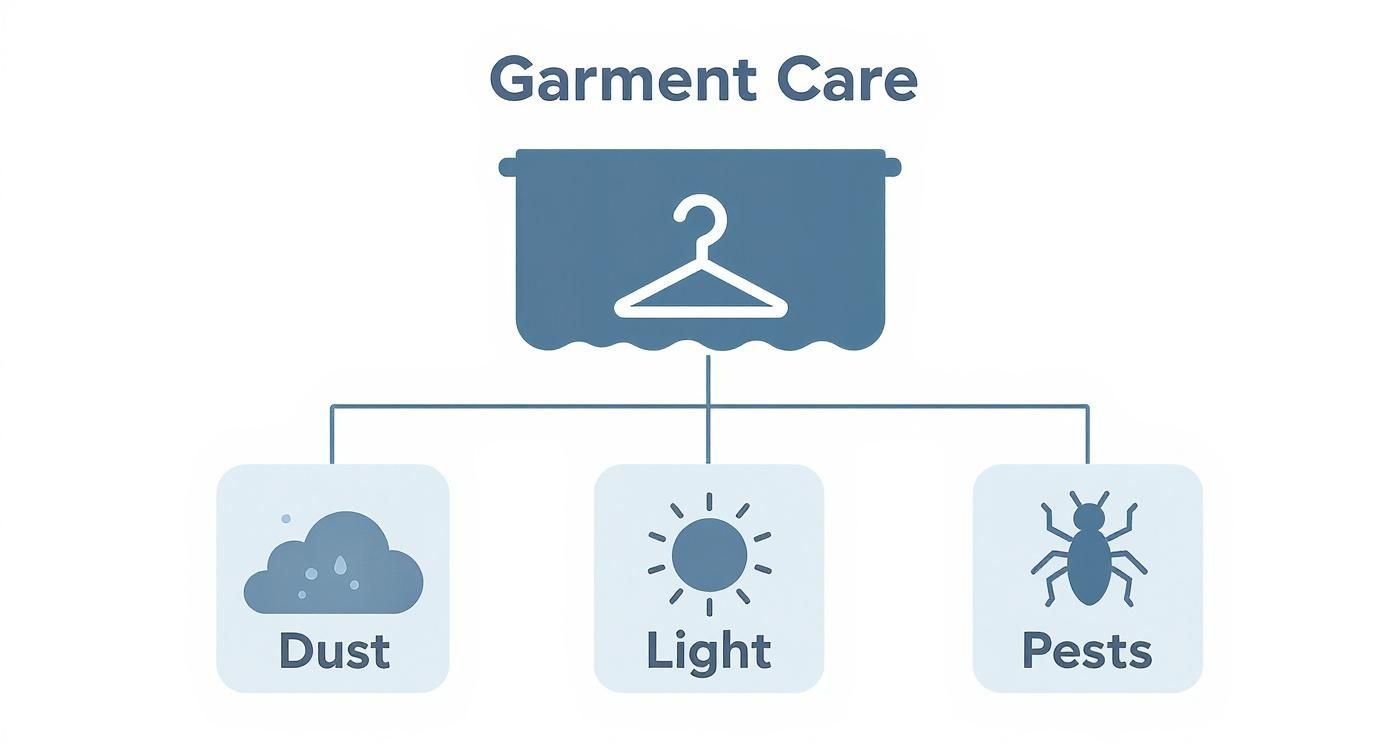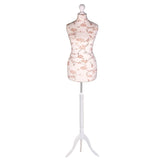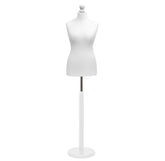A Retailer's Guide to Garment Rack Covers
A garment rack cover is far more than just a simple dust sheet. It’s a protective shield, designed to safeguard clothing from all the things that want to ruin it: dust, light, damp, and even pests. Think of it as essential insurance for your clothing investment.
Whether you're a retailer in the UK looking to protect valuable stock, a tailor keeping bespoke creations immaculate, or simply organising your seasonal wardrobe at home, the right cover is key. It preserves the integrity of the fabric and keeps your garments looking sharp and professional.
Why a Garment Rack Cover is Non-Negotiable
A good garment rack cover is a fundamental tool for proper clothing care and inventory preservation. In any environment, from a hectic retail stockroom to a quiet home studio, your clothes are constantly at risk from the elements. A quality cover is your first line of defence, making sure every item remains in pristine, ready-to-wear condition.
This is especially critical in a commercial setting. For a retailer, protected stock means fewer items get marked down because of soiling or sun-fading. For a tailor, it's the guarantee that a client's finished piece stays flawless right up until the moment of collection. They’re a small detail that makes a big difference in professional clothing care.
A well-chosen garment rack cover is a proactive investment in quality control. It prevents the slow, cumulative damage from environmental exposure that can devalue inventory and ruin carefully crafted pieces over time.
This proactive mindset is catching on. In fact, the UK has seen a real uptick in the use of garment rack covers, partly driven by more compact urban living and a growing need for smarter storage. The UK home textile market, which includes these protective items, is projected to hit USD 7.62 billion in 2025.
Key Benefits for Professionals and Hobbyists
Using a garment rack cover delivers both immediate and long-term wins. The advantages go way beyond just keeping things clean; they touch on organisation, efficiency, and ultimately, the lifespan of your clothing.
- Protection from Contaminants: The most obvious plus is shielding clothes from the dust, dirt, and airborne grime that inevitably settles into fabrics.
- Defence Against Fading: Covers block out direct sunlight and harsh artificial lighting, preventing the UV damage that leaches colour from your garments.
- Moisture and Pest Barrier: A good cover provides a crucial barrier against dampness that can lead to mustiness, as well as insects that can wreak havoc on delicate textiles.
- Enhanced Organisation: Covering your racks creates a much neater, more uniform look. This makes it far easier to manage stock and maintain a tidy, professional space, which is a core principle in our guide to the best practices for inventory management.
Beyond guarding against these common threats, garment rack covers are an excellent way to put professional storage practices into action. For some great related advice, you can explore these tips on how to store freshly cleaned clothes.
Choosing the Right Material for Your Garment Rack Cover
When it comes to protecting your stock, picking the right material for your garment rack cover isn't just a minor detail—it's the most critical decision you'll make. The fabric you choose will determine everything from the level of protection it offers to how long it will last in your specific setting. It’s the difference between a simple dust sheet and a true guardian for your valuable inventory.
Think of it like this: a heavy-duty canvas cover is the rugged overcoat for your clothes, built for the challenging conditions of a stockroom or long-term storage. A clear vinyl cover, on the other hand, is more like a practical raincoat; it keeps dust and moisture out while ensuring everything underneath remains perfectly visible, ideal for a bustling retail floor or a tailor’s workshop.
The material you select has a direct effect on the health of your garments. A non-breathable plastic might seem fine for keeping dust off for a few days, but over the long term, it can trap moisture. In the often-damp UK climate, that's a recipe for musty odours or even mould.
Matching Fabric to Function
Different materials are designed to solve different problems. Getting to grips with their core strengths will guide you to a cover that genuinely serves its purpose, whether you're safeguarding delicate silks from sunlight or shielding sturdy workwear from warehouse dust. The aim is to create the perfect micro-environment for the clothes on your rail.
This infographic breaks down the main threats a good garment rack cover should defend against.

As you can see, a cover’s main job is to create a physical barrier against the three biggest culprits of damage: dust, light, and pests.
A Closer Look at Common Cover Materials
To help you decide, let's compare the most popular options on the market. Each has its own set of pros and cons, making them suitable for different scenarios, from busy shop floors to quiet home studios.
Garment Rack Cover Material Comparison
This table offers a quick comparison of the common materials you'll encounter, highlighting where each one shines and what to look out for.
| Material | Key Feature | Best For | Considerations |
|---|---|---|---|
| Clear Vinyl (PVC) | Transparency & Waterproof | Retail displays, workshops, short-term stock protection. | Can become brittle over time and lacks breathability. |
| Non-Woven Polypropylene | Breathability & Lightweight | Long-term storage of natural fibres (wool, cotton, silk). | Offers less protection against heavy-duty wear and tear. |
| Heavy-Duty Canvas | Durability & Opaque | Warehouses, stockrooms, transit, and long-term archival. | Can be heavy and bulky; its opacity hides contents. |
| Polyester | Versatility & Water-Resistant | General use in retail backrooms, studios, and home storage. | Breathability can vary depending on the fabric's weave and finish. |
Each of these materials serves a distinct purpose. Vinyl is all about visibility, polypropylene is for letting fabric breathe, canvas offers brute strength, and polyester provides a reliable, all-round solution. Your choice ultimately hinges on balancing protection, visibility, and the specific needs of your garments.
Choosing the right material is an exercise in foresight. Think about not just what you need to protect your garments from today, but the conditions they will face over the next few months or even years.
Protecting hanging garments is one piece of the puzzle. For more advice on keeping your workspace organised, have a look at our expert guide on creating efficient storage for fabrics to ensure all your textiles stay in pristine condition. A smart material choice now can save you from costly damage down the line.
Finding the Perfect Cover Design for Your Space
It's one thing to choose the right material, but it's the design of a garment rack cover that really determines how useful it will be day-to-day. The right design should work with you, not against you, whether you’re managing a busy shop floor or archiving precious pieces in a stockroom. Think of it like picking the right tool for the job – it makes a world of difference to your efficiency and how well your garments are protected.
A cover’s construction dictates how you get to the clothes underneath. So, you need to ask yourself a few questions. How much access do you really need? How often will you be pulling items off the rail? And what's the main job of this cover? Is it for a display that’s always changing, for long-term storage, or for moving stock around?

Full Enclosure Versus Open Access Designs
The biggest design choice you’ll face is whether to go for a full enclosure or a more open, partial cover. Each one has a very different, but equally important, role to play in a professional or home environment.
A full-zip enclosure cover is the ultimate bodyguard for your garments. It creates a 360-degree shield, sealing the rack completely from top to bottom. This design is your best bet for:
- Long-term storage, when you’re putting away seasonal stock or personal wardrobes and need a solid barrier against dust and moths.
- Protecting a client’s finished garment in a tailor's studio, keeping it pristine until they come to collect it.
- Safeguarding inventory in a stockroom, where dust and the risk of damage are ever-present.
On the other hand, simple shoulder covers offer a much more focused solution. These just drape over the tops of the hangers, protecting the shoulders of the clothes from dust while leaving everything else visible. They're perfect for a busy shop floor, as they keep display items clean without hiding the product from your customers.
The design of your garment rack cover should enhance, not hinder, your daily operations. An enclosed cover offers maximum security for static items, while an open design prioritises visibility and quick access for active inventory.
Specialised Covers for Specific Needs
Beyond those two main styles, you'll also find covers designed for more niche tasks. A transparent vinyl cover, for example, gives you all the protection of a full enclosure but with the massive bonus of complete visibility. This is a game-changer for quick stock checks, letting you see exactly what’s on the rail at a glance without having to unzip anything.
For retailers and designers who are always moving clothes to events, photo shoots, or between stores, a heavy-duty transport cover is an absolute must. These are usually made from tough canvas or thick polyester and often have reinforced seams and industrial-strength zips to handle the knocks and bumps of being in transit.
Picking the right design is a fundamental part of presenting your stock effectively. To get more ideas on creating an attractive retail space, take a look at our expert visual merchandising guidelines. When you match the cover's design to its real-world use, you can be sure your garments are getting exactly the protection they need.
How to Measure Your Rack for a Perfect Fit
A garment rack cover that doesn't fit properly is a bit like a suit that's two sizes too big. It looks sloppy and, frankly, it just doesn't do its job. To get the best protection for your garments, taking accurate measurements of your rack isn't just a good idea—it's the essential first step. It's a simple process that will save you the headache of returns and exchanges later on.
Think of it as getting a suit tailored for your rack. A cover that’s too tight will pull at the seams and put stress on the zips every time you use it. One that’s too loose will sag, gather dust in the folds, and look untidy. Getting the measurements spot on from the start is the key to a professional look and proper function.

The Three Core Measurements
To make sure you choose the right size, you only need three key dimensions. Grab a tape measure and let's get started.
- Height: Measure from the very top of the hanging rail straight down to the floor. This is crucial: if your rack has wheels, you must include them in the final measurement.
- Width: Measure the full length of the top hanging rail, from one end to the other. If your rack has extendable arms, you'll need to decide whether you want the cover to fit them when they are retracted or fully extended, and measure that total width.
- Depth: This is the side-on measurement of the rack. Measure the distance from the front of the frame to the back to determine how snugly the cover will wrap around the ends.
While it's a different garment, the principles of careful measuring are universal. The guide on how to measure for a perfect cap and gown fit also highlights just how important accuracy is for getting things right the first time.
Snug Fit vs. Looser Fit
Should your cover be skin-tight or have a bit of room to breathe? The answer really depends on how you plan to use it. Is it for long-term archival storage, or do you need quick access in a busy stockroom?
A snug fit creates the best seal against dust, moisture, and pests, making it the perfect choice for storage. A slightly looser fit—think an extra 2-3 cm in width and depth—makes taking the cover on and off much quicker for daily use.
For example, a tailor archiving a bespoke wedding dress would want that snug, protective fit. On the other hand, a retail manager who needs to constantly access stock for the shop floor will appreciate the convenience of a looser cover.
Of course, the rack itself is the foundation. If you're still deciding on the right frame for the job, our guide on choosing a heavy-duty clothing rack can help you find one that suits your needs. Keep these points in mind, and you’ll be able to order the perfect garment rack cover with confidence.
Installation Tips and Long-Term Care
https://www.youtube.com/embed/T23ZycUV3dk
Getting the most out of your garment rack covers—and protecting the clothes inside—really comes down to a bit of thoughtful installation and regular care. It doesn't take much effort, but it makes a huge difference in ensuring your investment pays off for years to come.
The initial setup is simple, but getting it right from the start is key. First, give your clothing rack a quick wipe down to make sure it's clean and dry. When you’re ready to put the cover on, drape it gently from the top, guiding it down over the frame. This helps avoid catching the material on any sharp corners or fittings.
A quick word on zips: handle them with a bit of care. They’re often the first part to give way if you're too rough. If a zip feels stuck, don't force it. Just check the fabric isn't caught in the teeth and gently work it free. It’s a small habit that can save you a lot of frustration later on.
Keeping Your Cover in Top Condition
Regular cleaning is a must for keeping dust at bay and maintaining that professional look. But how you clean your cover depends entirely on what it’s made of. Different materials need different handling to prevent damage.
Here’s a quick guide to cleaning based on the material:
- Vinyl and PVC Covers: These are the easiest to look after. Simply wipe them down with a damp cloth and a little mild detergent. Their non-porous surface makes cleaning a breeze.
- Canvas Covers: For any marks, it's best to spot-clean with a gentle fabric cleaner and a soft brush. Try not to soak the material, as thick canvas can take a very long time to dry out properly.
- Polyester and Non-Woven Covers: Spot-cleaning is your best bet for light soiling. If it needs a more thorough clean, check the manufacturer's label first—some can handle a gentle, cold machine wash.
Always make sure your cover is 100% dry before putting it back on the rack. Trapping any moisture underneath can lead to a musty smell, completely defeating the purpose of protecting your garments.
Long-Term Strategies for Durability
Beyond the day-to-day cleaning, a few good habits will significantly extend the life of your cover. Every so often, give it a quick inspection for any signs of wear and tear, especially around the seams and zips. Catching a small tear early stops it from becoming a major problem.
Also, make sure there’s some ventilation around the covered rack. While covers are great for keeping dust off, stagnant air isn't ideal for fabrics over long periods. If you’re not using the cover, fold it neatly and store it somewhere cool and dry, away from direct sunlight, which can degrade the material over time.
Of course, a good cover needs a solid foundation. The right framework is just as important. You can find more advice on choosing the best setup in our guide to clothes rails and brackets.
Sustainable Wardrobe Management and Garment Care
When you think about sustainable fashion, a garment rack cover probably isn't the first thing that springs to mind. But it's a perfect example of how small, practical choices can make a real difference. Using one is a simple way to connect everyday garment protection with the bigger idea of responsible consumption.
Think about it: by shielding your clothes from dust, sunlight, and moisture, you're actively making them last longer. This small step directly supports the 'buy less, choose well' philosophy, reducing the need to replace perfectly good items that just weren't stored correctly.
Reducing Your Environmental Footprint
Every piece of clothing saved from damage is one less item heading to a landfill, and that’s a bigger deal than you might think. The scale of textile waste is genuinely staggering.
The UK, for instance, is Europe's fourth-largest producer of textile waste, churning out around 206,456 tonnes every single year. It’s estimated that the average Brit throws away about 3.1kg of textiles annually. Using something as simple as a garment rack cover helps chip away at those numbers. You can find more sobering statistics on UK fashion waste and its impact here.
Suddenly, that cover isn't just a dust sheet; it's a practical tool for sustainability. For a retailer, it means less stock getting damaged and written off. For a tailor or hobbyist, it means your creations or treasured vintage finds are kept in mint condition for years.
A garment rack cover is an investment in longevity. By protecting what you already own, you reduce consumption, minimise waste, and take a tangible step towards more sustainable practices in your home or business.
A Practical Approach to Conscious Consumption
Living more sustainably doesn't always have to be about grand, sweeping changes. More often, it’s the small, consistent habits that add up. Weaving garment rack covers into your storage routine is a perfect example of this in action.
Here’s a breakdown of how it really helps:
- Prevents Needless Replacements: It stops easily avoidable damage, like a silk blouse fading in a sunny room or a bespoke suit collecting dust between fittings.
- Maintains Garment Value: Clothes kept in pristine condition hold their value far better, whether for resale or simply for your own long-term enjoyment.
- Supports a Circular Mindset: When you take good care of your garments, you’re ensuring they have the best chance at a long life—be it through being worn, resold, or eventually passed on.
At the end of the day, effective garment care is sustainable garment care. It’s a proactive choice to value the resources we already have, making it a cornerstone of any modern, responsible approach to wardrobe management.
Your Questions Answered: Garment Rack Covers
When you're looking to protect your stock or your personal collection, a few questions naturally pop up. Getting the right answers means you'll choose a cover that does the job properly, so let’s clear up some of the most common queries we hear from retailers and enthusiasts.
Are All Covers Breathable?
Not at all. Breathability comes down entirely to the material used. Think of it like a jacket: some are designed for a downpour, others to let your skin breathe.
Fabrics like non-woven polypropylene and classic canvas are inherently breathable. They allow air to circulate, which is vital for long-term storage. This simple feature prevents that musty smell and stops mould from getting a foothold, especially if you’re storing clothes in a place with unpredictable humidity.
On the other hand, materials like PVC or vinyl are the complete opposite. They're non-breathable by design. Their job is to create an impenetrable barrier against dust and water, making them perfect for a chaotic stockroom or for protecting garments during a quick move.
The golden rule is simple: breathable for long-term storage of natural fibres, and non-breathable for short-term, heavy-duty protection where visibility or waterproofing is the priority.
Can I Use One Outdoors?
Tempting, but most standard covers are built for indoor life. A heavy-duty waterproof model will certainly get you through a day at an outdoor market, but it's not designed for permanent exposure to the elements. Over time, things like direct sunlight will make materials like vinyl brittle and cause them to degrade.
If you regularly need to keep racks outside, you’ll want to hunt down a cover specifically rated for it. Look for features like UV protection and properly weatherproofed seams—that’s what really shields clothes from sun and rain damage.
What's the Best Way to Clean My Cover?
It really depends on what it’s made of. The manufacturer's label is always your first port of call, but here are some reliable tips:
- Vinyl and PVC: These are the easiest to look after. A wipe with a damp cloth and a bit of mild cleaner is usually all it takes to have them looking new again.
- Canvas and Non-Woven Fabric: For these materials, it’s best to spot-clean. A gentle fabric cleaner will lift marks and dirt without damaging the material itself.
- Polyester: Some of the tougher polyester covers might handle a gentle, cold machine wash. But please, double-check the care tag first before you risk it.
Whatever the material, make sure the cover is completely air-dried before you put it back on the rack. It’s a small step, but it’s the key to making sure you don’t trap any dampness in with your garments.
Ready to give your garments the professional protection they deserve? At Display Guru, we offer a curated selection of high-quality garment rails and storage solutions perfect for any retail or home setting. Explore our collection and find the ideal fit for your needs at https://www.displayguru.co.uk.








